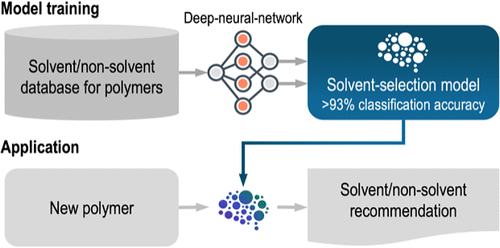当前位置:
X-MOL 学术
›
Macromolecules
›
论文详情
Our official English website, www.x-mol.net, welcomes your
feedback! (Note: you will need to create a separate account there.)
A Deep Learning Solvent-Selection Paradigm Powered by a Massive Solvent/Nonsolvent Database for Polymers
Macromolecules ( IF 5.1 ) Pub Date : 2020-06-11 , DOI: 10.1021/acs.macromol.0c00251 Anand Chandrasekaran 1 , Chiho Kim 1 , Shruti Venkatram 1 , Rampi Ramprasad 1
Macromolecules ( IF 5.1 ) Pub Date : 2020-06-11 , DOI: 10.1021/acs.macromol.0c00251 Anand Chandrasekaran 1 , Chiho Kim 1 , Shruti Venkatram 1 , Rampi Ramprasad 1
Affiliation

|
Polymer solubility is critical for a variety of industrial and research applications such as plastics recycling, drug delivery, membrane science, and microlithography. For novel polymers, it is often an arduous process to find the appropriate solvents for polymer dissolution. Heuristic approaches, such as solubility parameters, provide only limited guidance with respect to solvent prediction and design. The present work highlights a novel data-driven paradigm for solvent selection in polymers. For this purpose, we utilize a deep neural network trained on a massive data set of over 4500 polymers and their corresponding solvents/nonsolvents. This deep-learning framework maps high-dimensional fingerprints/features to compact chemically relevant latent space representations of solvents and polymers. When these low-dimensional representations are visualized, we observe the spontaneous clustering of nonpolar, polar-aprotic, and polar-protic behavior. This large-scale data-driven approach possesses an overall classification accuracy of above 93% (on a hold-out set) and significantly outperforms existing methods to determine polymer/solvent compatibility such as the Hildebrand criteria.
中文翻译:

大规模溶剂/非溶剂数据库为聚合物提供支持的深度学习溶剂选择范例
聚合物溶解度对于各种工业和研究应用至关重要,例如塑料回收,药物输送,膜科学和微光刻。对于新型聚合物,寻找合适的溶剂来溶解聚合物通常是一个艰巨的过程。启发式方法(例如溶解度参数)仅提供有关溶剂预测和设计的有限指导。本工作重点介绍了用于聚合物中溶剂选择的新型数据驱动范例。为此,我们利用深度神经网络对超过4500种聚合物及其相应溶剂/非溶剂的海量数据集进行了训练。这种深度学习框架将高维指纹/特征映射为紧凑的溶剂和聚合物的化学相关潜在空间表示形式。当可视化这些低维表示时,我们观察到非极性,非质子非质子和质子非极性行为的自发聚类。这种大规模的数据驱动方法拥有总分类精度超过93%(在保留集上),并且大大优于现有的确定聚合物/溶剂相容性的方法(例如Hildebrand标准)。
更新日期:2020-06-23
中文翻译:

大规模溶剂/非溶剂数据库为聚合物提供支持的深度学习溶剂选择范例
聚合物溶解度对于各种工业和研究应用至关重要,例如塑料回收,药物输送,膜科学和微光刻。对于新型聚合物,寻找合适的溶剂来溶解聚合物通常是一个艰巨的过程。启发式方法(例如溶解度参数)仅提供有关溶剂预测和设计的有限指导。本工作重点介绍了用于聚合物中溶剂选择的新型数据驱动范例。为此,我们利用深度神经网络对超过4500种聚合物及其相应溶剂/非溶剂的海量数据集进行了训练。这种深度学习框架将高维指纹/特征映射为紧凑的溶剂和聚合物的化学相关潜在空间表示形式。当可视化这些低维表示时,我们观察到非极性,非质子非质子和质子非极性行为的自发聚类。这种大规模的数据驱动方法拥有总分类精度超过93%(在保留集上),并且大大优于现有的确定聚合物/溶剂相容性的方法(例如Hildebrand标准)。











































 京公网安备 11010802027423号
京公网安备 11010802027423号